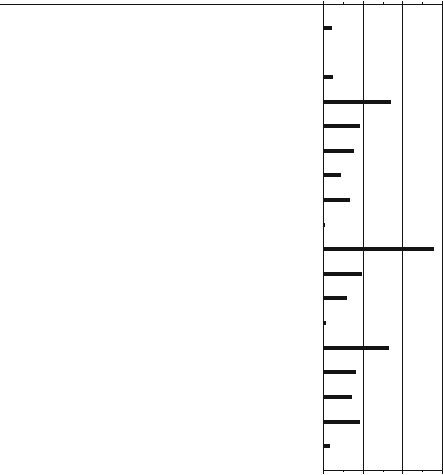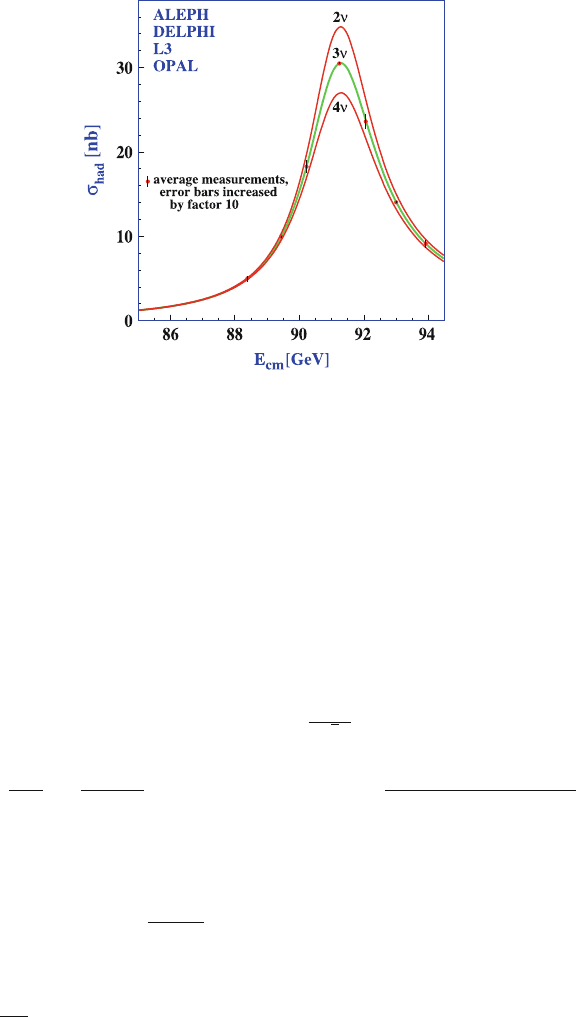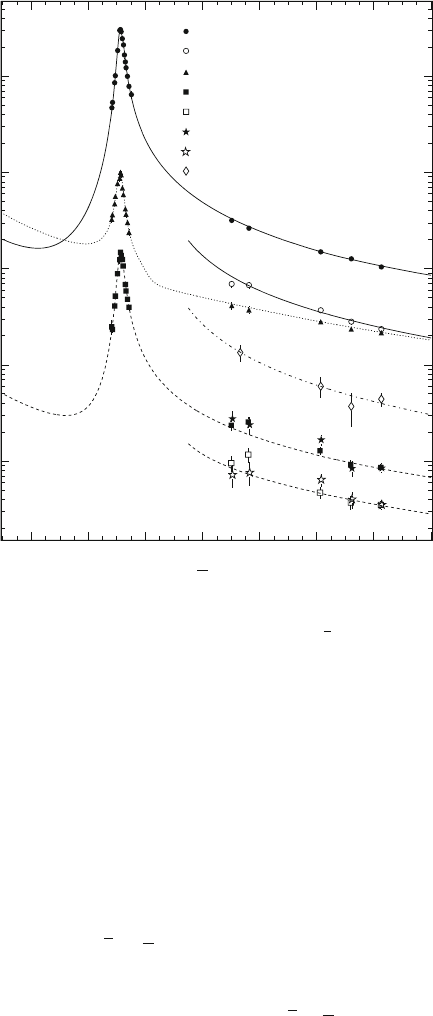Braibant S., Giacomelli G., Spurio M. Particles and Fundamental Interactions: An Introduction to Particle Physics
Подождите немного. Документ загружается.


9.7 e
C
e
Collisions at E
cm
91 GeV. The Z
0
Boson 249
This behavior is typical of a resonance with J D 1, described by the Breit–Wigner
formula with a width depending on the number of channels kinematically accessible.
From the experimental point of view, measurements were made (at LEP) through a
series of scans around the Z
0
mass, at c.m. energies between 88 and 94 GeV. Similar
measurements were performed at SLAC.
The cross-section
f
N
f
around the Z
0
peak is given by (7.25) with the same
changes discussed in Sect. 9.3.2 for the formation of the J= resonance. The
quantity
ff
is the partial width corresponding to the Z
0
decay into f
N
f; Z
0
! f
N
f
and
Z
is the Z
0
total width. Using the de Broglie wavelength (neglecting the
electron mass) ¯ D„=p !„=E D„=.
p
s=2/ and defining .s/ .s/
e
C
e
!f
N
f
,
Eq. 7.25 becomes
.s/ D
4
.s=4/
3
4
ee
ff
=4
.
p
s m
Z
/
2
C
2
Z
=4
D
12
m
2
Z
s
ee
ff
.s m
2
Z
/
2
C s
2
2
Z
=m
2
Z
(9.17)
in unit „Dc D 1; in the last equality we approximated s ' m
2
Z
. To ensure
correct dimensions, (9.17) must be multiplied by .„c/
2
. The factor 3=4 D .2J C
1/=Œ.2s
a
C 1/.2s
b
C 1/ takes into account the Z
0
angular momentum and the spin
s
a
D s
b
D 1=2 of the final state fermions. At s D m
2
Z
,(9.17) becomes
0
.s D m
2
Z
/ D
12
m
2
Z
ee
ff
2
Z
: (9.18)
9.7.2 Z
0
Total and Partial Widths
Since the Z
0
is unstable, the width of its peak has a finite value related to the number
of species of fermions in which it can decay. Each kinematically accessible species
(i.e., with a mass <
m
Z
0
2
) that couples to the Z
0
contributes to the width of the
resonance.
The contribution of each fermion-antifermion pair may be estimated using the
usual Feynman rules and considering the Z
0
as a real particle decaying into two
bodies. The width is connected with the lifetime (and to the transition probability
W , Eq. 4.28) by the uncertainty principle D„= D„W . The transition
probability can be estimated from dimensional considerations: the decay is due to
the weak interaction, and hence is proportional to the Fermi constant G
F
. Since the
Fermi constant has dimension [Energy
2
], the width (which has dimension of
an energy) is obtained by multiplying by a factor with dimension [Energy
3
]. The
only physical quantity involved in the process that has dimension of an energy
is the Z
0
boson mass; therefore, Eq. 4.44 can be expressed as „W D
G
F
m
3
Z
. The calculation of the numerical factor (which comes from the phase-space
momentum integration) is beyond the difficulty level of this text (see [9M98]); the
full calculation gives a factor equal to 1=6
p
2.

250 9 Discoveries in Electron-Positron Collisions
Table 9.4 Z
0
partial decay widths and branching ratios in
various channels, as measured by several experiments and
estimated by global fits as reported in [P08]. The
invis
is not
directly measurable and refers to the decay into neutrinos.
h
is the total hadronic width,
`
is the decay width in any
charged lepton pair
Process (f f )
ff
(MeV) BR (%)
e
C
e
83:91 ˙ 0:12 3:363 ˙ 0:004
C
83:99 ˙ 0:18 3:366 ˙ 0:007
C
84:08 ˙ 0:22 3:370 ˙ 0:008
`
;`
C
`
83:984 ˙ 0:086 3:3658 ˙0:0023
h
1;744:4 ˙ 2:0 69:91 ˙ 0:06
Z
(total) 2;495:2 ˙ 2:3 100
invis
,
P
`De;;
l
l
499 ˙1:5 20:0 ˙0:06
In addition to the numerical factor, for the computation of the decay fractions
ff
into fermion pairs, one should keep in mind that: (1) in the weak interaction,
particles interact both through an axial part and through a vector part, (2) while the
leptons do not have a color multiplicity, each quark has three degrees of freedom
(one for each color quantum number). Finally, we can write
ff
D
G
F
m
3
Z
6
p
2
.a
2
f
C v
2
f
/N
f
C
D 330.a
2
f
C v
2
f
/N
f
C
MeV (9.19)
where v
f
and a
f
are respectively the vector and axial coupling constants of the
fermion f (they will be obtained from the Standard Model in Chap.11, see Table
11.3). N
f
C
is the color factor (three for the quarks and one for the leptons).
The partial width
ff
defined above represents the transition probability per time
unit for the Z
0
boson decay to a given final state f
N
f .Table9.4 summarizes the
measurements of the partial widths and decay branching ratios for each channel.
Note that the probability that the Z
0
decays into
P
`
`
`
(20%) is significantly
larger than that for the decay in a particular lepton pair `
` (3%). The Z
0
coupling
with fermions is different and more complicated (as we shall see in Sect. 11.3) than
that of the W
˙
, which couples only to left-handed fermions.
The hadronic width,
h
, is the sum of partial widths of quark-antiquark pairs
kinematically accessible in the final state, that is,
h
uu
C
dd
C
ss
C
cc
C
bb
: (9.20)
The top quark is excluded because it is too heavy to be produced at the Z
0
peak.
ee
;
;
;
are the leptonic widths. The “invisible width,”
invis
, is not
directly measurable and refers to the decay into neutrinos
invis
N
N
(9.21)

9.7 e
C
e
Collisions at E
cm
91 GeV. The Z
0
Boson 251
where N
is the number of light neutrino families.
invis
is obtained by subtracting
the other known widths from the total width:
invis
D
Z
h
ee
D
Z
h
N
``
: (9.22)
We assume the lepton universality,thatis,
ee
D
D
D
``
.
The measured total width,
Z
, results from the sum of the partial widths,
ff
,of
all known fermions, that is,
Z
h
C
ee
C
C
C N
D
vis
C
invis
' 2:5 GeV: (9.23)
From Table 9.4, it is clear that the Z
0
predominantly decays into hadrons (about
70% of all decays).
The Z
0
lifetime can be estimated from the uncertainty principle:
Z
'„=
Z
D
6:58 10
22
=2;495 D 2:7 10
25
s; it is a very short lifetime. The decay is due to
the weak interaction, but the phase space factor is very large.
9.7.3 Measurable Quantities,
invis
and the Number of Light
Neutrino Families
Figure 9.10 summarizes the quantities which were accurately measured at e
C
e
colliders. For the Z
0
peak, they refer to
• The resonance mass, m
Z
(GeV), obtained from the measurement of the cross-
section. The mass corresponds to the position of the maximum of the Breit–
Wigner curve
• The total width,
Z
(GeV), also obtained from the shape of the resonance curve
• The hadronic cross-section,
0
had
(nb), corresponding to the maximum of the
resonance. The percentage of hadronic events is determined by the topology of
events with jets (Fig. 9.8b). From (9.18) and using
ff
D
h
, the hadronic cross-
section at the Z
0
peak (the so-called “pole” cross-section) is
0
had
D
12
ee
h
m
2
Z
2
Z
: (9.24)
Inserting numerical values in the above equation, one obtains
0
had
D 40:2 nb.
With the typical LEP luminosity, L 10
31
cm
2
s
1
(see Problems 9.4 and 9.5),
the frequency of hadronic event production is 0.4 Hz
• The electron and muon pair production cross-sections measured in a similar way
as the hadronic cross-section
• The partial widths,
ff
;
ee
, which are proportional to the peak cross-sections,
ff
=
ee
D
f
=
e

252 9 Discoveries in Electron-Positron Collisions
Measurement Fit |O
meas
−O
fit
|/σ
meas
0123
0123
0.02758 ± 0.00035
0.02766
m
Z
[GeV]
91.1875 ± 0.0021
91.1874
Γ
Z
[GeV]
2.4952 ± 0.0023
2.4957
σ
had
[nb]
0
41.540 ± 0.037
41.477
R
l
20.767 ± 0.025
20.744
0.01714 ± 0.00095
0.01640
A
l
(P
τ
)
0.1465 ± 0.0032
0.1479
R
b
0.21629 ± 0.00066
0.21585
R
c
0.1721 ± 0.0030
0.1722
0.0992 ± 0.0016
0.1037
0.0707 ± 0.0035
0.0741
A
b
0.923 ± 0.020
0.935
A
c
0.670 ± 0.027
0.668
A
l
(SLD)
0.1513 ± 0.0021
0.1479
0.2324 ± 0.0012
0.2314
m
W
[GeV]
80.392 ± 0.029
80.371
Γ
W
[GeV]
2.147 ± 0.060
2.091
m
t
[GeV]
171.4 ± 2.1
171.7
sin
2
θ
eff
(Q
fb
)
lept
A
FB
0,c
A
FB
0,b
A
FB
0,I
Δα
had
(m
Z
)
(5)
Fig. 9.10 Results [9w1] obtained by combining the measurements of the four LEP experiments at
CERN (ALEPH,DELPHI, L3 and OPAL) and of the SLD experiment at SLC, in e
C
e
collisions
around the Z
0
mass. The “pull” for each measurement is also presented; the “pull” is defined as
the difference between the measured value and the expected value in the Standard Model in unit of
uncertainty on the measurement
An important result from LEP and SLD was the determination of the number
of lepton families and thus, of the number of N
families of “light neutrinos” with
a mass smaller than half the Z
0
mass. If there was a fourth family of quarks and
leptons with masses below half the Z
0
mass, the number of channels in which the Z
0
could decay, would be larger than expected from the Standard Model computation
assuming three families. Experimentally, this would correspond to a larger Z
0
width
(and to a smaller lifetime) and a smaller cross-section peak.
To determine N
, the ratios R
0
f
are defined as
R
0
e
h
=
ee
R
0
h
=
R
0
h
=
: (9.25a)
Assuming lepton universality, these three ratios are equal, that is,
R
0
l
h
=
``
: (9.25b)

9.7 e
C
e
Collisions at E
cm
91 GeV. The Z
0
Boson 253
This quantity is measured using the ratio of the different event topologies (final
states with hadronic jets or leptons). Using Eq. 9.23 and the lepton universality, we
can now define the ratio as
R
0
invis
invis
``
D
Z
h
3
``
``
: (9.26)
From (9.24), one obtains
Z
D
q
12
ee
h
m
2
Z
0
had
,and(9.25b) becomes
R
0
invis
D
s
12R
0
l
0
had
m
2
Z
R
0
l
3: (9.27)
Using the experimental values of R
0
l
,
0
had
and m
Z
given in Fig. 9.10, one obtains
R
0
invis
D 5.943 ˙0.016.
This value can be compared with the prediction of the Standard Model for the
number of generations of light neutrinos, N
,
R
0
invis
invis
``
D N
N
``
SM
: (9.28)
The value of the ratio .
N
=
``
/
SM
in the Standard Model is 1.99125˙0.00083,
which can be derived from (9.19). This result leads to the determination of the
number of generations of light neutrinos, that is,
N
D
5:943 ˙ 0:016
1:99125 ˙ 0:00083
D 2:984 ˙ 0:008: (9.29)
The dependence of the hadronic cross-section on the number N
is clearly visible
in Fig. 9.11, which presents the cross-section for the process e
C
e
! hadrons,
for c.m. energies around 91 GeV. The precision achieved in this measurement places
stringent limits on the possible contribution of any invisible decay of the Z
0
,other
than the decays due to the three known generations of light neutrinos. In fact, the
behavior is in perfect agreement with the existence of three families of neutrinos.
9.7.4 Forward–Backward Asymmetries A
FB
At energies below the resonance, the process e
C
e
! =Z
0
!
C
occurs
either through the exchange of a photon (electromagnetic interaction with the cross-
sectionin(9.5), or a Z
0
(weak interaction) and through an interference term
between the two processes. At first order, the differential cross-section can be
written (neglecting the fermion masses) as
d
d˝
D
˛
2
4s
N
f
C
Œa.1 C cos
2
/ C2b cos (9.30)

254 9 Discoveries in Electron-Positron Collisions
Fig. 9.11 Cross-section for the process e
C
e
! hadrons around a c.m. energy of 91 GeV.
The points are the experimental data obtained with the four experiments at the LEP collider at
CERN; the central curve is the theoretical prediction assuming that there are three different types
of neutrinos, the upper (lower) corresponds to the prediction with two (4) types of neutrinos [P08]
where is the outgoing fermion scattering angle with respect to the e
beam.
The Standard Model predicts the value of the quantities a and b,seebelow.The
integration of the term .1 C cos
2
/ of (9.30) provides the total cross-section for
each type of final state f
N
f . The linear term in cos does not contribute to the total
cross-section given that
R
0
cos d = 0, but contributes to the so-called forward–
backward asymmetries.
Note that (9.17 and 9.18) apparently do not explicitly contain the parameter that
characterizes the weak interaction, i.e., the Fermi constant. In fact, it is “hidden” in
the partial widths (9.19). Recalling that
ee
D
G
F
m
3
Z
6
p
2
.a
2
e
C v
2
e
/,Eq.9.17 becomes
.s/ D
12
m
2
z
s
G
2
F
m
6
Z
2 6
2
2
.v
2
e
C a
2
e
/
X
f
N
f
C
.v
2
f
C a
2
f
/
1
.s m
2
Z
/
2
C s
2
2
Z
=m
2
Z
:
(9.31)
At the Z
0
peak (s D m
2
Z
), one gets
0
D
G
2
F
m
4
Z
6
2
Z
.a
2
e
C v
2
e
/
X
f
.a
2
f
C v
2
f
/N
f
C
;
and the sum extends over all fermion f kinematically accessible, i.e., with a mass
m
f
<
m
Z
0
2
.

9.7 e
C
e
Collisions at E
cm
91 GeV. The Z
0
Boson 255
Equation 9.31 allows one to calculate, for example, the cross-section for the
production of a muon pair in the final state. With a
e
D a
D1=2 and neglecting
v
e
and v
(see Table 11.3), one finds
.e
C
e
! Z
0
!
C
/
m
Z
0
D
G
2
F
96
sm
4
Z
.s m
2
Z
/
2
C
2
Z
m
2
Z
: (9.32)
Equation 9.32 gives a cross-section of 1.6 nb at the Z
0
peak. The radiative
corrections reduce it to 1.2 nb. This value can be compared with the cross-section
of 0.0105nb due to the electromagnetic interaction.
For energies below 90 GeV, neglecting s with respect to m
2
Z
and since
Z
m
Z
,
Eq. 9.32 is approximately
.e
C
e
! Z
0
!
C
/
E
cm
<90 GeV
D
G
2
F
96
.„c/
2
s D 1:8 10
7
s.GeV
2
nb/:
(9.33)
Far from the Z
0
peak, the cross-section due to the weak interaction is much
smaller than that due to the electromagnetic interaction given in (9.5). Below
50 GeV, the contribution due to the weak interaction can therefore be neglected
(Fig. 9.1b).
Since the Z
0
coupling with fermions depends on both the vector and axial
coupling constants, v
f
and a
f
, one can observe measurable asymmetries in the
angular distributions of the final state fermions, as shown in Fig. 4.11. These
asymmetries allow one to quantify the parity violation in the neutral current weak
interaction.
The asymmetry in the angular distribution of the process e
C
e
! =Z
0
!
C
is relatively easy to measure:
A
FB
D
N
F
N
B
N
F
C N
B
D
F
B
F
C
B
(9.34)
where “F” stands for “forward” and N
F
is the number of muons scattered in the
forward hemisphere, i.e., with a diffusion angle such that cos >0with respect
to the direction of the e
beam. “B” stands for “backward” and N
B
is the number
of muons scattered in the backward hemisphere, i.e., with a diffusion angle such
that cos <0.
F
and
B
are the corresponding cross-sections. Considering only
the neutral current, the differential cross-section is given by [9M98]
d
d cos
D
3
8
0
Œ.1 C cos
2
/ C 2A
e
A
f
cos (9.35)
where
A
f
D
2v
f
a
f
v
2
f
C a
2
f
D 2
v
f
=a
f
1 C .v
f
=a
f
/
2
; (9.36)

256 9 Discoveries in Electron-Positron Collisions
(1) (2) (3) (4)
e
+
e
–
γ/Z
0
q
g
g
q
–
H
A
D
R
O
N
S
Fig. 9.12 Multihadronic production model
and similarly for A
e
. The values of the axial and vector constants predicted by the
Standard Model are given in Table 11.3. At the Z
0
peak, the forward–backward
asymmetry for each f
N
f channel is
A
0;f
FB
D
3
4
A
e
A
f
: (9.37)
Using other measurements of A
e
, the parameters A
, A
, A
c
and A
b
can be
measured using (9.37). A
c
and A
b
can be measured only if events where cc, bb
quark pairs are produced and identified with vertex detectors. At the Z
0
peak, the
forward–backward asymmetry, for example, for channels with a charged lepton pair
in the final state, e
C
e
! Z
0
! l
C
l
, is (Fig. 4.11)
A
0;l
FB
D 0:01714 ˙ 0:00095: (9.38)
The fact that the value is statistically different from zero is significant: it provides
further evidence of the parity violation in the weak interaction.
9.7.5 Multihadronic Production Model
In the annihilations e
C
e
! =Z
0
! q Nq,theq and Nq hadronize through the strong
interaction. The multihadronic production proceeds through four distinct phases, as
shown in Fig. 9.12.

9.8 e
C
e
Collisions for
p
s > 100 GeV at LEP2 257
1. In the first phase, the e
C
e
pair annihilates in a virtual or Z
0
, which give rise
to the primary q
q pair. Before the annihilation, the initial e
C
or e
can radiate a
. This reduces the total effective c.m. energy. The production of the primary q
q
pair is described by the perturbative electroweak theory which involves distances
of the order of 10
17
cm.
2. In the second phase, the quark or the antiquark can radiate a gluon, which
subsequently can radiate another gluon (producing, in this way, a three-gluon
vertex), or produce a q
q pair. This phase is described by the perturbative QCD
and occurs at distances of the order of 10
15
cm.
3. In the third phase, the colored partons (quarks and gluons) fragment (hadronize)
in colorless hadrons. The process (which occurs at distances of the order of the
fm) cannot be treated with perturbation methods; in the absence of an exact
analysis, the fragmentation is described by models.
4. In the fourth phase, the produced hadronic resonances decay rapidly into hadrons
through the strong interaction (e.g.,
0
!
C
,
0
10
23
s); other hadrons
decay in hadrons via the electromagnetic interaction (˙
0
!
0
;
0
! ,
0
10
16
s). At this stage, the process is described with models that include
experimental information about the branching ratios and lifetimes. At a longer
time scale, most of the hadrons decay via the weak interaction. We will return to
the hadronization process in Sect. 10.6.1.
There are several programs for Monte Carlo simulation, generating full multi-
hadronic events. For example, the Monte Carlo JETSET includes the parton shower
for phase (2) and the string fragmentation (also called Lund) for phase (3). The
free parameters of the models are optimized by studying the shape variables of
multihadronic events. Information on decays are “manually” introduced on the basis
of experimental measurements. All Monte Carlos have the fact that the subsequent
processes are independent from one another in common; for example, the decay of
a hadron is independent of its production.
9.8 e
C
e
Collisions for
p
s > 100 GeV at LEP2
In this section, the processes produced in e
C
e
collisions with
p
s > 100 GeV (i.e.,
the second phase of LEP operation, the so-called LEP2 phase) are presented. The
main results obtained at LEP2 are:
• The measurement of the triple vertex boson Z
0
W
C
W
• The accurate measurements of the W boson parameters and mass (m
W
)
• The variation with energy of many hadronic parameters such as the number of
charged particles produced in the collision (charged multiplicity)
• Limits on the existence of new particles

258 9 Discoveries in Electron-Positron Collisions
cross-section / pb
s′/s>0.7225
×0.1
s′/s>0.7225
×0.1
1
10
10
2
10
3
10
4
60 80 100 120 140 160 180 200
e
+
e
–
→ hadrons
e
+
e
–
→ hadrons; s′/s>0.7225
e
+
e
–
→ e
+
e
–
;|cosθ
e-
|<0.7;θ
acol
<10˚
e
+
e
–
→ μ
+
μ
–
e
+
e
–
→ μ
+
μ
–
; s′/s>0.7225
e
+
e
–
→ τ
+
τ
–
e
+
e
–
→ τ
+
τ
–
; s′/s>0.7225
e
+
e
–
→ bb
–
; s′/s>0.7225
÷s / GeV
Fig. 9.13 Dependence as a function of the c.m. energy of the cross-sections .e
C
e
!
hadrons/, .e
C
e
!
C
/ and .e
C
e
!
C
/ for 80 <
p
s < 183 GeV. The production
cross-sections for
C
and
C
are reduced by a factor 10. (The data for s
0
=s > 0:7225
exclude the radiative events)
9.8.1 e
C
e
! W
C
;W
;Z
0
Z
0
Cross-Sections
Cross-sections for the processes e
C
e
! e
C
e
,
C
,
C
, hadrons (see
Fig. 9.13) were measured for the first time at these high energies. The probability
that the initial positron or electron radiates a photon is very large when the
exchanged Z
0
is almost real. This phenomenon is the so-called “radiative return
to the Z
0
:” the events are no longer collinear, but acollinear (see the topology
shown in Fig. 9.14 to be compared with that shown in Fig. 9.6b). This implies that
the reaction e
C
e
! C .``; qq pair with the Z
0
mass), is almost twice as
abundant than that in which the fermion pairs in the final state have an energy
equal to twice the beam energy. In Fig.9.13, radiative events are removed with the
condition s
0
=s > 0:7225 where s
0
is the energy of the ``; qq system and s is the c.m.
energy.
